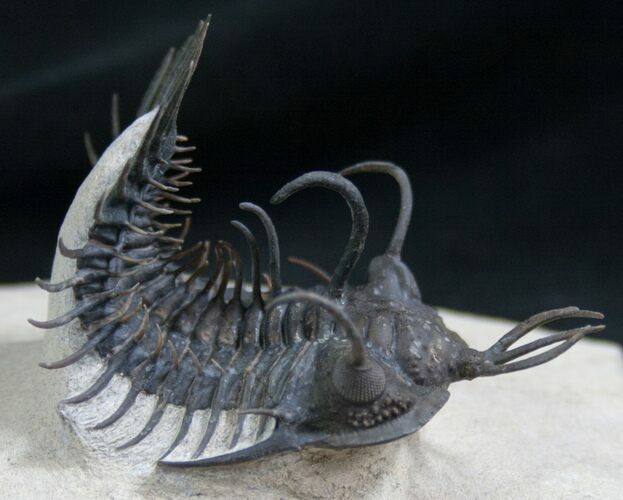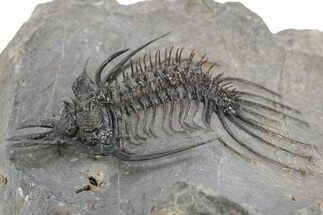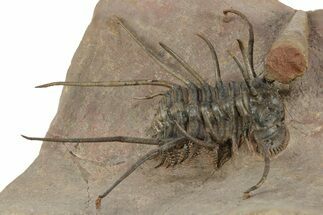This Specimen has been sold.
Beautifully Prepared Walliserops Hammi Trilobite
This is a spectacularly prepared specimen of the trilobite Walliserops hammi, often referred to at the "short trident" Walliserops. This specimen would be over 3 inches long if fully oustretched, the preservation and the preparation are SPECTACULAR. There is over 40, natural free-standing spines on this specimen and the matrix has even been removed from underneath the pygidial (tail) spines so they spread out like a fan. Just check out the detail in the eye facets. Only the most skilled preparators in the world can do this quality of work and more the 40 hours of labor likely went into the preparation of this trilobite.
There is some speculation that the long and short forked species may actually just represent sexual dimorphism within the type of trilobite. There also appears to be some substantial differences with the short fork specimens that I have previously offered from Timrzit, Morocco.
The only restoration on this specimen is about half of the spine above the left I eye was reconstructed and a touchup at the base of the fork. The last photo in the series shows the specimen pre restoration with the restored areas highlighted.
This is the best specimen of this species I've yet to offer for sale on FossilEra.
There is some speculation that the long and short forked species may actually just represent sexual dimorphism within the type of trilobite. There also appears to be some substantial differences with the short fork specimens that I have previously offered from Timrzit, Morocco.
The only restoration on this specimen is about half of the spine above the left I eye was reconstructed and a touchup at the base of the fork. The last photo in the series shows the specimen pre restoration with the restored areas highlighted.
This is the best specimen of this species I've yet to offer for sale on FossilEra.
Walliserops is a fascinating ancient arthropod that scoured the bottom of a shallow sea floor. It is placed in a genus of spiny, phacopid (acastid) trilobites and it is found in Lower to Middle Devonian (441-358 mya) rocks from Morocco. All species of Walliserops share the spectacular three-pronged "trident" that rises from the glabella. They also have horns over their eyes and intimidating spines along their backs.
Walliserops was highly specialized to deal with an oceanic wonderland in the diverse and dangerous Age of Fish. Specialization is a key difference from the more primitive “bugs” that emerged in the Cambrian.
Walliserops displays an unusual departure from bilateral symmetry. A notable example is the curved occipital spine of W. hammii, which takes a noticeable curl to one side. The regular development of these features in multiple specimens suggests a genetically controlled feature of the genus, not mutation or pathology. Some exceptions to bilateral symmetry can be explained by adaptations that allowed the trident to be held off the sea floor while walking.
The trident's function is an intriguing mystery. Many believe it was used to stir the ocean floor to better scavenge for food. Such a large adornment would have required significant energy and nutrient investment. Although a number of suggestions have been made (e.g. sensory apparatus, disguise or protection), many experts support an idea that the trident served as "horns" similar to present day beetles.
Morroco is an exciting place for discovering new and diverse species that lived in an ancient ocean that covered the northern reaches of the Sahara Desert. All three currently described Walliserops species come from the same strata near Foum Zguid in southern Morocco, though other locations have yielded new trilobites to study. This region is hailed as one of the great fossil treasure troves in the world.
Walliserops was highly specialized to deal with an oceanic wonderland in the diverse and dangerous Age of Fish. Specialization is a key difference from the more primitive “bugs” that emerged in the Cambrian.
Walliserops displays an unusual departure from bilateral symmetry. A notable example is the curved occipital spine of W. hammii, which takes a noticeable curl to one side. The regular development of these features in multiple specimens suggests a genetically controlled feature of the genus, not mutation or pathology. Some exceptions to bilateral symmetry can be explained by adaptations that allowed the trident to be held off the sea floor while walking.
The trident's function is an intriguing mystery. Many believe it was used to stir the ocean floor to better scavenge for food. Such a large adornment would have required significant energy and nutrient investment. Although a number of suggestions have been made (e.g. sensory apparatus, disguise or protection), many experts support an idea that the trident served as "horns" similar to present day beetles.
Morroco is an exciting place for discovering new and diverse species that lived in an ancient ocean that covered the northern reaches of the Sahara Desert. All three currently described Walliserops species come from the same strata near Foum Zguid in southern Morocco, though other locations have yielded new trilobites to study. This region is hailed as one of the great fossil treasure troves in the world.
SPECIES
Walliserops hammi
LOCATION
Foum Zguid, Morocco
SIZE
3" long if outstretched
CATEGORY
SUB CATEGORY
ITEM
#8145
We guarantee the authenticity of all of our specimens.
 Reviews
Reviews



















